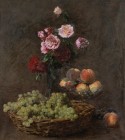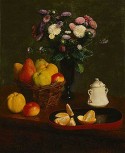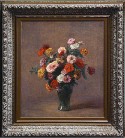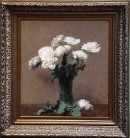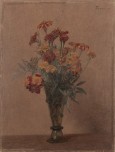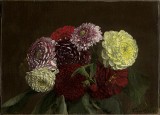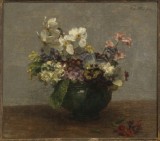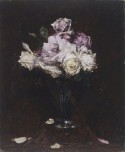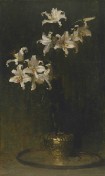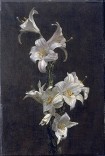The browser will either open the file, download it, or display a dialog.
Fantin-Latour in Australia
Introduction
Australia is described as "a country of immigration"[1] and its non-indigenous people as "a cutting from some foreign soil."[2] This is an apt metaphor for a postcolonial population cut from British stock, then transplanted to the Antipodes in the eighteenth century, and augmented, changed, and challenged throughout the nineteenth century by migrations of European (British and other) and Asian nationals. The floral metaphor can be extended by speaking of migration and settlement in terms of grafting, hybridizing, and acclimatizing.
In the early part of the nineteenth century, settlers viewed the landscape of Australia—including all flora and fauna—as "wild and uncivilised, almost indistinguishable from the Indigenous inhabitants."[3] The introduction, therefore, of flora and fauna from Britain was an attempt "to induce an emotional bond between Australian colonies and the mother country." [4] So too was the importation of art and artifacts from Britain, France, and other European countries, which was a further effort to maintain ties with the Old World.
The unexpected interest in nineteenth- and early-twentieth-century Australia in the still lifes of the French artist Henri Fantin-Latour (1836–1904) may be explained by the nostalgia of European immigrants for the common garden flowers (dahlias, zinnias, peonies, poppies, hollyhocks, and asters) and fruits (apples, pears, peaches, and grapes) that he depicted in his paintings.[5] Just as they preferred those cultivated European flowers and fruits over the wild vegetation found in Australia, so, too, they felt that his art was superior to that of Australian home-grown artists. Critics referred to Fantin's works acquired by public art collections as "treasures" and they felt certain that "these are good ones, and characteristic of the painter."[6]
It was important that they felt certain about the quality of the work because by 1900 Australians were accustomed to hearing that not only their own artists but also their art collections were inferior. For example, in 1898 a London critic concluded "there is no Australian art," but rather a culture in which Australian artists copied poor examples of British and European work.[7] Australians were anxious about their distance from Paris and London and as late as 1917 the journal Art in Australia, the most influential forum for art since its first publication in 1916, argued that "our remoteness from the rest of the world makes it difficult to know what is worthwhile in Art movements elsewhere."[8] In addition, critics were contemptuous of the unfortunate acquisition of European fakes and works of dubious origin such as "an alleged Watteau (surely, if genuine, the worst picture he ever painted)."[9] There were also reasons for British artists to feel reticent about having their works in colonial collections. For example, the Royal Academician Alfred East and his fellow painters, "would have preferred their major work to remain in England where it could be seen."[10]
This leaves us to wonder whether Henri Fantin-Latour ever turned his thoughts to the suitability of Australia as a destination for his work, given that two of his still life paintings were purchased for Australian public collections during his lifetime, and there is a possibility that four more were bought before his death for a private collection.[11] Did Fantin know about his paintings' travels? Did he care? Perhaps the answers to these questions will emerge in future international scholarship on Fantin-Latour. In Australia the nature of the available source material relating to Fantin allows only for the study of the acquisition and critical reception of his paintings and their impact on Australian artists. In this article, I will discuss the public collection history of Fantin-Latour's still lifes in Australia between 1890 and 1935.[12] I will demonstrate that though the number of Fantin still lifes that Australian museums and private collectors acquired was small by international standards, their impact was considerable. Fantin's still lifes were widely discussed and the artist had a substantial following including, most importantly, Australia's foremost critic in the 1920s, Lionel Lindsay (1874–1961), and one of Australia's best-loved painters Hans Heysen (1877–1968). In addition, Fantin's influence is apparent in the approach to flower painting of two major figures in the canon of Australian art, George Lambert (1873–1930) and Arthur Streeton (1867–1943).
Fantin-Latour's Still Lifes in Public Australian Collections
Though best known today for his large-scale group portraits of important artists, writers, and musicians of his day, Henri Fantin-Latour was a prolific still-life painter, who painted nearly six hundred flower or fruit pictures in the course of his career.[13] Most of these works were destined for the British market; the artist submitted a total of sixty-eight paintings, mostly of flowers and fruits, to the Royal Academy exhibitions between 1862 and 1890[14] and regularly sent still lifes to his London agents Ruth and Edwin Edwards for sale in England.[15] Before 1872, when the French dealer Durand-Ruel bought twenty-two of his still lifes, all of Fantin's flower and fruit paintings were sold to English buyers.[16] Indeed, Edward Lucie-Smith claims that Ruth Edwards's success at selling Fantin's flower paintings in England made this branch of his work "virtually unknown in France," compared to his portraits and imaginative paintings on musical themes.[17]
In his 1927 monograph of Fantin, published twenty-three years after the artist's death, Gustave Kahn noted that the artist's works were owned by public collections in France, Germany, Belgium, Britain and the United States, but he failed to point out that three of the artist's still lifes had entered into public collections in Australia[18] and that one had traveled as far south as New Zealand (fig. 1).[19] Kahn evidently was unaware that, as he was writing, the Australian public was so enamored with Fantin-Latour that they were flocking to the museums that owned his still lifes. Referring to the early still life, Flowers and Fruit (fig. 2) that was bought by the Art Gallery of New South Wales, for example, the editor of Art in Australia wrote that the public was "making pilgrimage to the little masterpiece."[20] Australians were pleased with the idea that they owned a significant number of Fantin-Latour's still lifes. Writing in 1924, the art critic Lionel Lindsay claimed:
We are certainly fortunate in possessing so many [still lifes by Fantin-Latour]. Adelaide Gallery houses "White Poppies" and the matchless "Zinnias". T. Barr Smith, Esq., of Adelaide, owns two, Melbourne Gallery the same number, and at last Sydney Gallery has its "Fantin."[21]
By 1935 five flower paintings had been acquired for public collections in Sydney, Adelaide and Melbourne.[22] In 1922 another five paintings by the artist, including flower paintings, were recorded as belonging to the private collectors Joanna and Robert Barr Smith in Adelaide, but only a small number of people, among them Lionel Lindsay and Hans Heysen, were privy to this information and had seen these paintings.[23] Australians may have felt they were fortunate to own so many works by Fantin-Latour, but in reality the total number of paintings in Australia by 1935 was modest, given Fantin's extraordinary output.[24] Today, the national collection of Fantin-Latour's work is roughly equal in size to the collection of his paintings in the Victoria and Albert Museum in London.[25]
The Passage of Fantin-Latour Paintings to Public Collections in Australia
Australian public art galleries began buying for their collections in the second half of the nineteenth century. Tight budgets led to a principle of acquiring only one or two examples of the work of each artist to ensure a useful and comprehensive representation of contemporary British and, to a lesser extent, continental European art.[26] The Art Gallery of New South Wales in Sydney, for example, was established in the 1870s and in the first decades of collecting concentrated on works by living British artists, aiming to acquire "at least one major work per year."[27] Like other Australian museums, the Sydney gallery employed London representatives to build its collection. They purchased the majority of the works from the Royal Academy exhibitions, and some from the Paris Salon, and shipped them to Australia.[28] Among their early acquisitions were historical and genre scenes—often very large in scale—by John Everett Millais, Edward Poynter, Ford Maddox Brown, Luke Fildes, J. Brett, and Frank Brangwyn.[29] Between 1890 and 1900 the acquisitions also included works by Lord Frederick Leighton, John William Waterhouse, and George Frank Watts. In 1893 Edward Bevan, writing for the journal Antipodean, claimed that New South Wales had the "finest art collection in the Southern Hemisphere."[30] Bernard Smith, Australia's most distinguished art historian, was later to refer to this method of building colonial collections as demonstrating of Australia's "dependence upon English fashions."[31]
The National Gallery of South Australia, which opened in Adelaide in 1881, also concentrated its collection policy on contemporary art from Britain. The Gallery's curator between 1892 and 1909, Harry P. Gill—whose tastes have recently been described as "quite distinctive and more refined than that of his inter-colonial colleagues, less bourgeois Victorian realist, more purely Aesthetic"[32]—purchased works by Lawrence Alma-Tadema, Aubrey Beardsley, Brangwyn, Leighton, Dante Gabriel Rossetti, Edward Burne-Jones, Poynter, and Watts. In 1899 Gill traveled to London to spend £10,000—a large sum of money by Australian standards—from the Elder Bequest Fund.[33] The bequest—the first major philanthropic gift to an Australian museum—was bequeathed to the Adelaide Gallery by Sir Thomas Elder, a local businessman and livestock farmer who died in 1897.[34] In England, Gill formed an advisory committee comprised of British artists Ernest Waterlow, Edward Gregory, and Poynter, who was President of the Royal Academy and Director of the National Gallery.[35] During the 1899 trip, on a visit to artists' studios, dealers, and museums, Gill purchased Fantin-Latour's Zinnias (c.1897–99; fig. 3) from Ruth Edwards,[36] and, in 1906, he bought a second floral still life by Fantin-Latour titled Poppies (1891; fig. 4) from a private collection.[37]Poppies is a seemingly simple painting that looks as if it took no effort at all to paint. In fact, it is a tour de force of balance and harmony in color and form. Its visual clarity is the outcome of strong contrasts between white, green, and brown, and its focus on a single motif against a plain background enhances the illusion of simplicity. In addition, it exhibits an austerity that Michel Hoog recognized in relation to a different Fantin work from this period titled Larkspurs ( 1892).[38] In both paintings the artist has concentrated on one type of flower, and in both the flowers are luminously white, producing an overall effect that is cold, crisp, and severe.
The National Gallery of Victoria in Melbourne has the largest number of paintings by Fantin-Latour. Its first purchase of a still life by the artist was Marigolds (fig. 5), which it acquired in 1892 at The Royal Anglo-Australian Exhibition, a prestigious annual event in Melbourne that was initiated in 1885 and aimed to bring the best examples of the "English school" to Australia.[39] The inclusion of a work by Fantin-Latour, a French artist, in this exhibition illustrates how familiar his flower paintings had become in English art circles. In 1906, with the help of a bequest from Alfred Felton,[40] the Gallery bought its second Fantin-Latour still life, Dahlias (1863; fig. 6). Felton, on his death in 1904, had left a large sum of money to the Gallery—approximately £2,000,000—to "raise and improve public taste."[41]Dahlias is similar to a Fantin-Latour painting of the same title and subject, dated 1877, in the collection of the Victoria and Albert Museum in London. In both paintings the flowers, presented without a vase, are set against a deep, rich background, with the head of each flower individuated as if a portrait. These paintings call to mind Jacques-Emile Blanche's comment that "Fantin studied each flower, its grain, its tissue, as if it were a human face."[42]
Dahlias was one of a group of British and French works that the artist George Clausen bought in London, with money from the Felton Bequest, for the Melbourne Gallery.[43] By July 1906 Clausen had spent his allocation of £1,951 1s on thirteen paintings and twenty-two drawings, including some small French works (Corot's Sketch at Scheveningen, now "attributed to" him, and paintings by Fantin-Latour and Vollon), although most were contemporary British. He reported enthusiastically that drawings by Burne-Jones, Lord Leighton, Ruskin, and others would be of great value to students, and that the paintings he had acquired would make the Gallery's collection representative of the best work of the times.[44]
Clausen's purchase, however, was controversial. In December 1906 Australian landscape artist Arthur Streeton commented to his colleague, the artist Tom Roberts, that there was "very little satisfaction at Clausen's purchase."[45] But Clausen's inclusion of Fantin-Latour—whose flower paintings were at the height of their popularity in Britain at this time—in his selection was in keeping with the Gallery's intention to build a world-class collection.[46] Fantin was sought after in fashionable London society but he, himself, observed that the people who bought his work were more impressed by his "fine clothes" and only secondarily interested in art.[47] Were Fantin's upper middle-class patrons impressed by the way his paintings complemented their sense of refined and elegant culture? Australians certainly were. In Australia, Fantin's flower paintings were admired for their elegance and "aristocratic spirit."[48]
Floriculture and Nostalgia
Fantin-Latour's popularity in England, and Australia's early dependence on British taste, go a long way to explain the artist's popularity in Australia. But other colonial desires and aspirations should be brought into the discussion of his popularity in the Victorian and Edwardian periods in Australia. The first wave of interest in Fantin-Latour in Australia coincided with a period when floriculture played a major role in daily life and when flowers acquired important economic as well as symbolic value. This new significance of flowers was not unique to Australia and, in fact, had its origins in Europe. Jack Goody captured the extent of the importance of flowers in nineteenth-century culture in England and France when he wrote:
This was the era of the horticultural societies, the flower shows and competitive displays, of the universal gardener and of the literary garden into which Tennyson invited Maude. So much took place with flowers and gardens that for Baudelaire flowers became evil symbols of a world he had rejected.[49]
In Australia, floriculture—and horticulture, in general—were vital to the individual and social acclimatization of settlers. David Goodman writes about the pleasure that British settlers obtained from the successful cultivation of northern hemisphere vegetables and fruits in Australian soil, and how the sight of flowers and plants from "home" was sometimes an overwhelming emotional experience. Flowers, in particular, were reminders of the past but also generated feelings of loss and regret. They were powerful vehicles for emotions such as nostalgia, and for longings and desires connected with memory. Goodman recounts the reaction of a certain George Baker when, sailing into Port Phillip Bay in 1852, the pilot's men came on board his ship, bringing "with them a bunch of Australian flowers as a sign of Welcome. They were double stocks and scented Geraniums with others just like the dear old Flowers I used to cultivate so carefully at home + they nearly brought tears into my eyes for it made me think of poor Charly and her little garden.[50]
Flowers could transport homesick migrants back in time and space to their place of origin. One colonial artist, John Dicksee, made this psychological phenomenon the subject of a lithograph titled The First Primrose (1856)which depicts a room crowded with people eager to see the first blossom of an English primrose picked from a newly cultivated garden in Australia. Katie Holmes, Susan K. Martin, and Kylie Mirmohamadi argue that this print has an important place in Australian cultural history for the way it illustrates the social significance and symbolism of gardens and flowers in the lives of early European settlers.[51]The first bloom of the primrose was proof that life could continue as before, even under different skies, if gardens were tended and the landscape shaped by the flora of Britain and Europe.
Though many of his flower paintings were produced in Buré, Normandy, where he spent the summers on the summer estate of his wife's family, the flowers that Fantin-Latour painted were common in English cottage gardens: roses, dahlias, marigolds, and zinnias. In Britain, Fantin was most famous for his paintings of roses due to their popularity in that country, which in the second half of the century had become a leader in rose cultivation.[52] Indeed, so close was the identification of Fantin with roses that later in the Twentieth Century the "Fantin-Latour" rose was named after him.[53]
Given the emotive power of flowers it is easy to imagine how Fantin's paintings of popular English garden varieties could evoke nostalgia for "home" among his Australian audience; the colonial gaze transformed these paintings into portraits of England. It is also easy to imagine how they threw into sharp relief the difference between northern hemisphere flowers and the robust, dark, and primitive banksias that grew naturally in Australia. Finally, Fantin's paintings call up the activity of gardening, an occupation with symbolic importance in a country that was in the process of "taming" the landscape, and in a culture in which gardens were seen as a "civilising and a quietening force."[54]
The importance of floriculture and a floral aesthetic in Australian upper-middle-class culture is exemplified by Joanna and Robert Barr Smith. Robert Barr Smith, who had emigrated from Scotland to Adelaide in 1854, married Joanna Elder in 1856. The Barr Smiths surrounded themselves with familiar European plants and flowers not only by bringing seeds for agriculture to the New World, but with the artworks they owned. Among the five paintings by Fantin-Latour they reputedly owned, four were referred to as flowerpieces.[55] Among them, Spring Bouquet (1879; fig. 7), which their grand-daughter later recalled was acquired, like the others, through their agents in London, is now in the collection of the Carrick Hill Estate in Adelaide.[56] Interestingly, the Barr Smiths were also passionate collectors of products of the Arts and Crafts movement and were among Morris & Co.'s most important international clients.[57] In 1883, Joanna and Robert made the long ship voyage to London where they lived for two years. They shopped at Morris & Co. and purchased enormous quantities of a wide range of Morris's furnishings to redecorate their many houses in Adelaide. Floral motifs abounded in the rich array of chintzes and other fabrics, carpets and embroideries, wallpaper, glassware, and furniture that they selected. Daffodils decorated their curtains, and an array of roses, tulips, fuchsias, and marigolds adorned their armchairs. The silk brocatelle designed by J. H. Dearle that decorated their armchairs was woven with flowers in various stages of opening, from bud to fully-blown, a reminder that earthly life is dynamic and also transient.[58] When we try to imagine the Barr Smith home, with its flower printed wallpapers and upholstery and Fantin's still lifes on the wall, it is clear that for this immigrant couple flowers were the means by which they tried to create for themselves a corner of Britishness in the far reaches of Adelaide.
Beauty and Truth: Fantin-Latour's Critical Reception
Though paintings by Fantin-Latour came to Australia as early as the 1890s, it was not until the 1920s that critics began to write about his work in a serious way. By then, modernism had made some strides in Australia, and the critics who wrote about Fantin were mostly conservative ones who held up his work as an example of beauty and truth in art.
Conservative art criticism was the hallmark of Art in Australia, a popular journal, whose founder and editor Sydney George Ure Smith (1887–1949) promoted the view that correct drawing and observation of nature were the sine qua non of great art; and "whatever lay behind an art object must be drawn from the knowledge of its physical presence."[59] The journal supported local and international artists who made draftsmanship the primary goal of their practice.
The conservatism of Ure Smith and the critics and artists in his circle may be related to one effect of the recently ended world war; it caused many in Australia, as elsewhere, to feel nostalgic for the nineteenth century—a period the artist and critic Lionel Lindsay referred to as the time before the world was "disturbed by the machine, the craze for speed and cheap luxury."[60] Not surprisingly, Lindsay was particularly charmed by Fantin's work, which seemed representative of his view of the nineteenth century as an age of calm and grace.
In 1924 Lindsay wrote an article on the work of Fantin-Latour in Art in Australia,in which he called Fantin the successor to Chardin:
He is best and deservedly known as a painter of flowers. In this province he stands alone, continuing the tradition of Chardin, intimate and unmannered. His instinct for arranging flowers in their right setting is, like his taste, faultless, because it is so unpretentious. He never forced his subject, but liberated the charm which had attracted him, and of the flower, he gives us everything but its scent.[61]
Lindsay further explained the connection he saw between Fantin-Latour and Chardin, finding in both the virtue of a "quiet relationship of the painter with his subject-matter [that] is entirely absent from modernist work."[62] The apparent "timelessness" of still life was a marker of its strength, setting it apart from what was considered by the conservative factions in Australia as the passing fashion and masquerade of modernism:
Once the fashion of the hour has passed, there is no escape from the inquiring eye of truth. Then is the masquerader unmasked, the hireling stripped of his temporary honours. Only the true artist, clad in his native sincerity, shall survive.[63]
In a passage in an article on the Australian artist Hans Heysen, Lindsay discussed what he saw as Fantin's greatest strength, namely his sensitivity to the beauty of simple things:
To paint flowers well one must have a special temperament. The freshness and fragility, the brief splendor of the flower's life—apotheosis of "Useless Beauty"—which spends its essence in a day, may only be captured by a sensitive mind and an able hand. Fantin had this special endowment above all other painters. His clairvoyance was extraordinary, almost feminine, his taste as rare as the Chinese and Japanese in this genre, to which he adds the extra dimension of reality our western vision demands. It was not in the vapours of his romanticism, the Wagnerian lithographs, but before a simple bowl of blooms, that his invention quickened to the revelation of beauty. He loved the things he painted, graced them with his particular charm, and his beautiful technique, quiet and resourceful, is never flagrant with the virtuoso's pride.[64]
A Fantin-Latour School
By discussing Fantin's work in an article on a contemporary Australian still-life painter, Lindsay legitimized Australian flower painting, which throughout the nineteenth century had been in low esteem. As late as 1897, a critic had expressed relief that "there are fortunately but few still lifes and flower paintings."[65] But by linking Australian flower painters to a European artist whose works were found in major Australian museums, early twentieth-century critics slowly established respectability for their works. Alice Bale's unidentified painting of a bowl of zinnias, for example, was complimented because it "challenges comparison with the works of the famous Fantin-Latour on the same subject in both the Melbourne and Adelaide Galleries."[66] And when Lionel Lindsay commended the artist Hans Heysen on a successful still-life painting, he described how it transported him "to a plane of happiness that I have only felt before Fantin."[67]
Heysen was one of three Australian artists whose flower paintings became highly respected in the first three decades of the twentieth century; the other two were George Lambert and Arthur Streeton. While all three are more famous today for their landscapes and portraits, in their own time their still lifes were much admired, and they were responsible for making flower painting a respectable professional activity.
The three artists were close acquaintances, and all were friends of Lionel Lindsay, with whom they shared an admiration for Fantin-Latour's work.[68] Lindsay wrote with unreserved praise about all three, and devoted more critical space to their flower paintings than did any other Australian writer. He described two of George Lambert's flower paintings as among "the finest flower pieces of our age."[69] One of these, Tulips and other stimulants (1927), purchased for the Sydney gallery, resembles that gallery's Fantin-Latour Flowers and Fruits (fig. 2) which it acquired in 1923. Both artists set an array of everyday domestic items within a shallow space, and both include a vase of flowers and a bowl of fruit in addition to an assortment of containers.[70]
Lambert was only the second Australian to be elected an Associate Member of the Royal Academy in London and he had easy access to Fantin-Latour's work when he lived in London from 1901 to 1921.[71] For part of 1901 he also lived in Paris, quite near Fantin-Latour, according to the memoirs of his wife, Amy Lambert, who described the French artist as an embittered man who would "wantonly destroy one of his beautiful small canvases as an expression of cynical despair at ever achieving the reputation that now is so liberally his."[72]
Arthur Streeton, who lived in England from 1897 until the end of the First World War, was a frequent visitor to the Royal Academy where Fantin-Latour's paintings were hung.[73] Streeton's Roses (1929; fig. 08), a deceptively simple work that hides the complexity of its arrangement behind an economy of compositional elements and a restricted palette, shares many formal and conceptual similarities with Fantin-Latour's flower paintings. The triangular arrangement of flowers, echoed in the conical shape of the glass vase, is a combination found in many of Fantin-Latour's paintings including, for example, Tea and Tea-Noisette Roses (1879) in the City of Manchester Art Gallery.[74] Both paintings also are marked by the presence of aging blossoms at the moment before they succumb to gravity.
Streeton's painting Lilium Auratum, in the Art Gallery of New South Wales, (1933; fig. 09) may be compared with Fantin's White Lilies (1877; fig. 10) in the collection of the Victoria and Albert Museum. In both paintings the viewer looks into the open centers of the lilies, which are dramatically close to the picture plane,, twisting and turning around their stems and allowing us a view of every possible angle so that we might know the flower better, and so that we might wonder at the profusion of blossoms generated by such thin stems. Streeton's handling of the subject is less mysterious than Fantin's, since he contains the entire body of the plant within the picture frame, whereas the stem in Fantin's painting disappears to a place we cannot see. But both artists appear to enjoy the drama of the whiteness of the flowers against dark backgrounds, and of revealing to us the fertile centers of the lilies, flowers that for centuries have signified chasteness but here seem to celebrate a world of exotic fecundity.
Of the three artists, Hans Heysen was most frequently compared with Fantin-Latour. In 1908, his painting titled Zinnias was said to be "just as good as Fantin-Latour."[75] And in 1925 Lionel Lindsay reported that he "once heard a connoisseur say it was 'as good as Fantin's and much cheaper.'"[76] By 1920 Fantin-Latour had become known as Heysen's greatest influence:
He is also an admirable painter of flowers. I think he might have painted them if he had never seen Fantin-Latour's work, but I am sure that Fantin made him a master…Fantin's "Zinnias," in the Adelaide Gallery—the second best picture in Australia after the Melbourne Corot—is a masterpiece of masterpieces, a delight and a lesson in the art of flower painting that will stay as long as colour and canvas hold together.[77]
Heysen admired the French artist's ability to make his floral arrangements atmospheric by using backgrounds constructed from "grey space" and he noted the French artist's "relative tonal values and undefined edges."[78] In fact, he observed Fantin-Latour's methods in such detail that eventually there were claims that Heysen would "out-Fantin Fantin," especially in his depictions of zinnas.[79]
Conclusion
My aim with this article has been to draw attention to the circumstances surrounding Fantin-Latour's popularity with early curators, artists, patrons, and critics in Australia, and to add Australia's historical response to Fantin-Latour to Fantin studies. I have included critiques and commentaries on his work that were originally intended for antipodean readers only, in the days before national boundaries and national histories became as porous as they are today.
I have argued that the prevalence of floral subjects indicates a taste for the subject itself over and above the influence of prevailing English fashions for history and narrative paintings on colonial collections. In addition, I have claimed that nostalgia for the flora and fauna of Britain and Europe also played a part in the attraction of Australians to Fantin-Latour. And, lastly, I have suggested that in the conservative climate of the second decade of the twentieth century, and under the "threat" of modernism, artists and critics were attracted to the labor and skill, as well as the naturalism, of Fantin-Latour's paintings.
While the representation of Fantin-Latour in Australia is small by comparison with northern hemisphere collections, it is substantial within Australia. But until the first exhibition of Fantin-Latour is curated in Australia, and more scholarship is undertaken on the migration of his work to the Antipodes, we will never know how many paintings made the long sea-voyage from Britain in the late nineteenth century nor the extent of his popularity with Australians.
[1] Graeme Hugo, "An Australian Diaspora?," International Migration 44, no. 3 (2006), 106.
[2] Imants Tillers quoted in Steve Meacham, "Inspiration runs hot and cold," The Sydney Morning Herald,October 22, 2005, 4.
[3] Katie Holmes, Susan K. Martin and Kylie Mirmohamadi, Reading the Garden: The Settlement of Australia (Melbourne: Melbourne University Press, 2008), 11.
[4] Gavin Kendall, "'Governing at a Distance': Anglo-Australian Relations 1840–1870," Australian Journal of Political Science 32, no. 2 (1997): 223–36.
[5] Fantin-Latour's "flower paintings" were not always "still lifes" since the flowers were often shown without vases in indeterminate space. The distinction between flower painting and still life became blurred in the nineteenth century. See Josephine Walpole, A History and Dictionary of British Flower Painters 1650–1950 (Woodbridge: Antique Collectors' Club, 2006), 44.
[6] Howard Ashton, "Our Southern Collections," Art in Australia 3, no. 8 (1924): unpaginated.
[7] Dugald S. MacColl, "Australian Art," Saturday Review,London, April 16, 1898, in Bernard Smith, Documents on Art and Taste in Australia: The Colonial Period 1770–1914 (Melbourne: Oxford University Press, 1975), 218.
[8] "Editorial," Art in Australia,3rd no. (1917): unpaginated.
[9] Ashton, "Our Southern Collections," unpaginated.
[10] Heather Johnson, The Sydney Art Patronage System 1890–1940 (Grays Point, NSW: Bungoona Technologies Pty. Ltd, 1997), 17.
[11] The two paintings purchased for public collections before 1904 are: Marigolds, acquired by the National Gallery of Victoria in 1892 and Zinnias, acquired by the Art Gallery of South Australia in 1899.That four flower paintings were also acquired by private collectors Joanna and Robert Barr Smith from Fantin's London dealers, Edwin and Ruth Edwards, is documented by Sarah Thomas and Angus Trumble, Vive La France!: Hidden Treasures of French Art 1824–1945 (Adelaide: Art Gallery of South Australia, 1998), 49.
[12] I emphasize public collections rather than private collections due to the current uncertainty on the nature and extent of Fantin-Latour's representation in private collections in Australia. There is little scholarship on Fantin-Latour in Australia, and there have been no exhibitions of his work. However, three notable examples of Fantin-Latour paintings that have been acquired for public collections from private collectors are: Spring Bouquet which originally belonged to Joanna and Robert Barr Smith and is now in the Carrick Hill Estate collection; Poppies whichwas purchased in 1906 from Mrs Thomas Wigley, who was possibly an Australian collector, for the Art Gallery of South Australia; and Flowers and Fruit which was purchased from Australian collector S. Penton, for the Art Gallery of New South Wales, in 1923. As in New Zealand (see endnote 19) it is highly probable that works by Fantin-Latour have descended to successive generations of Australians and remain unknown to the general public.
[13] Walpole, History and Dictionary of British Flower Painters, 19.
[14] Petra ten-Doesschate Chu, "The Lu(c)re of London: French Artists and Art Dealers in the British Capital, 1859–1914," in Monet's London: Artists' Reflections on the Thames 1859–1941 John House, Petra ten-Doesschate Chu, and Jennifer Hardin, exh. cat.(St. Petersburg, FL: Museum of Fine Arts and Snoeck Publishers, 2005), 42.
[15] Douglas Druick, "Still-lifes 1870–1889," in Fantin-Latour,ed. Douglas Druick and Michel Hoog (Ottawa: National Gallery of Canada, 1983), 256–57.
[16] Ibid.,256.
[17] Edward Lucie-Smith, Henri Fantin-Latour (New York: Rizzoli, 1977), 13.
[18] Gustave Kahn, Fantin-Latour, trans. Wilfrid Jackson (London: John Lane the Bodley Head Ltd., 1927), 60–62.
[19] Fantin-Latour's work traveled to the South Island of New Zealand. One was recently discovered in a private home. Today, visitors to the website of the Christchurch Art Gallery Te Puna o Waiwhetu in Christchurch, can listen to actor Sam Neill describing the "beautifully modulated colour and a light-soaked warmth" of Fantin-Latour's Still Life (1893), a painting originally in a family home in Somerset, England, but that migrated to a small rural town in New Zealand in the early Twentieth century (fig. 01). "Henri Fantin-Latour, Still Life (1893)," Christchurch Art Gallery Te Puna o Waiwhetu,http://www.christchurchartgallery.org.nz/OnDemand/Audio/Collection/Works/?ID=fantin_latour_still_life (accessed September 8, 2009).
[20] "Editorial," Art in Australia 3, no. 8 (June 1924), unpaginated.
[21] Lionel Lindsay, "Fantin," Art in Australia 3, no. 8 (June 1924), unpaginated.
[22] The five works in public collections by 1935 are: Marigolds (1891) and Dahlias (1863)in the National Gallery of Victoria; Flowers and Fruit (1866) in the Art Gallery of New South Wales; Poppies (1891)and Zinnias (1897–99)in the Art Gallery of South Australia.
[23] Sarah Thomas and Angus Trumble, Vive La France!: Hidden Treasures of French Art 1824–1945 (Adelaide: Art Gallery of South Australia, 1998) 49. In addition, Hans Heysen wrote to Lionel Lindsay in 1922: "When in town the other day I came across 5 Fantin's and 2 of Anton Mauve's in a private home—and I cannot help feeling that my heart lies with these men who see intense and almost religious beauty in simple Nature that surrounds us—in the beauty of the skies and the mystery of the earth." Quoted in Colin Thiele, Heysen of Hahndorf (Adelaide: Rigby Publishers, 1976), 297.
[24] Six Fantin-Latour lithographs were purchased in 1913 by the Felton Bequest for the National Gallery of Victoria , through the Bequest's Advisors, Sir Sidney Colvin and Frank Gibson: Tannhaüser - Venusberg (1876); Evocation of Erda (1885); The Finale of Rheingold (1877); La Muse (1886); Dernier Thème de Schumann (1895); Etude de Femme Assise (1896). The Felton Bequest purchased two Fantin-Latour lithographs in 1927: Les Brodeuses (1898); and La Tentation De Saint Antoine (1893).
[25] The Victoria and Albert Museum in London has a collection of seven Fantin-Latour flower paintings, four of which were acquired by patrons who were contemporaries of Fantin. Three were bequeathed by the Ionides family, Fantin's patron from the Greek community in London in the 1860s. For a chronology of Fantin's life see Druick and Hoog, Fantin-Latour,12–19. For information on the collection of Fantins in the Victoria and Albert Museum see Victoria and Albert Museum, "Search the Collections," http://collections.vam.ac.uk/objectid/O80602, (accessed May 9, 2009).
[26] I am grateful to Richard Beresford, Curator of European Art at the Art Gallery of New South Wales, for meeting with me in August 2008 to advise me on the history of the Gallery's collection.
[27] Johnson, Sydney Art Patronage System, 16.
[28] No Fantin-Latours were purchased from the Paris Salon for Australian public collections, and significantly fewer works in general were bought at the Salon than at the Royal Academy. However, the Art Gallery of New South Wales purchased The First Born (1883), a narrative painting by Gaston La Touche (1854–1913), from the 1888 Paris Salon. For catalogue details and reproduction see, http://www.artgallery.nsw.gov.au/collection/browse, (accessed July 9, 2009). And Australian public collections did purchase through agents in Paris before 1900. For example, a large flower painting by Jean Robie, Flowers and Fruit (1877), was bought in Paris for the Art Gallery of New South Wales in 1879. For catalogue details and reproduction see http://www.artgallery.nsw.gov.au/collection/browse, (accessed July 9, 2009).
[29] Johnson, Sydney Art Patronage System, 16.
[30] Ibid., 17.
[31] Bernard Smith, Place, Taste and Tradition (Melbourne: Oxford University Press, 1979), 111.
[32] Ron Radford, "Introduction," in Ron Radford and others, The Story of the Elder Bequest (Adelaide: Art Gallery of South Australia, 2000), 14.
[33] Ibid., 12
[34] Ibid., 8.
[35] Angus Trumble, "The £10,000 London Buying Spree of 1899 and Beyond," inRadford and others, Story of the Elder Bequest, 69–70.
[36] "List of Works Purchased with the Elder Bequest" inRadford and others, Story of the Elder Bequest, 102.
[37] Ibid.,115
[38] Michel Hoog, "The Late Still-lifes," inDruick and Hoog, Fantin-Latour, 340–44.
[39] Caroline Jordan, "'Fletcher's of Collins Street': Melbourne's Leading Nineteenth-Century Art Dealer, Alexander Fletcher," The La Trobe Journal,no. 75 (2005): 83.
[40] Alfred Felton (1831–1904) emigrated to Australia from England during the 1850s gold rush in Victoria, and later made his wealth as a businessman. In his will he left a great deal of money in trust for the National Gallery of Victoria and for various charities. See J. R. Poynter, "Felton, Alfred (1831–1904)," Australian Dictionary of Biography, (Melbourne: Melbourne University Press, 1972), 4:162.
[41] John Poynter, "Art and Empire: Acquiring Art Works for the National Gallery of Victoria," in Exploring the British World: Identity, Cultural Production, Institutions, ed. Kate Darian-Smith and others (Melbourne: RMIT Publishing, 2004), 653.
[42] Jacques-Emile Blanche quoted in Lucie-Smith, HenriFantin-Latour, 22.
[43] John Poynter, Mr Felton's Bequests (Melbourne: The Miegunyah Press, 2003), 273–74.
[44] Ibid.
[45] R.H. Croll, ed., Smike to Bulldog: Letters from Sir Arthur Streeton to Tom Roberts (Sydney: Sydney Ure Smith, 1946), 78.
[46] Sonia Dean, European Paintings of the 19th and Early 20th Centuries in the National Gallery of Victoria (Melbourne: The National Gallery of Victoria, 1995), 53.
[47] Druick and Hoog, Fantin-Latour, 117.
[48] Lindsay, "Fantin," unpaginated.
[49] Jack Goody, The Culture of Flowers (Cambridge: Cambridge University Press, 1993), 232.
[50] George Baker quoted in David Goodman, "The Politics of Horticulture," Meanjin 47, no. 3, (1988): 403.
[51] Holmes and others, Reading the Garden, 25.
[52] Druick and Hoog, Fantin-Latour, 265.
[53] Graham Murphy, Old Roses (London: National Trust Enterprises, 2003), 50.
[54] Goodman, "Politics of Horticulture," 404.
[55] See endnote 23.
[56]Spring Bouquet (1879), was given to by Joanna and Robert Barr Smith to their daughter, Ursula Barr Smith, and now hangs in the art collection of her previous home, Carrick Hill Estate, which has been opened as a public museum. See Fiona Katherine Menzies, "French and British Art at Carrick Hill, Adelaide," (Honours Thesis, Fine Arts Department, University of Melbourne, 1992), 23. For a history of the Carrick Hill estate and the art collection belonging to the original owners of the house, William Hayward and Ursula Hayward (nee Ursula Barr Smith) see Carrick Hill, "History," at http://www.carrickhill.sa.gov.au/history.html, (accessed July 9, 2009).
[57] Christopher Menz, Morris and Company: Pre-Raphaelites and the Arts and Crafts Movement in South Australia, exh. cat. (Adelaide: Art Gallery Board of South Australia, 1994), 42.
[58] For historical information about Morris & Co. items acquired by the Barr Smiths, and for photographs of fabrics and furnishings, see ibid., 104–5.
[59] Joanna Mendelssohn, Lionel Lindsay: An Artist and His Family (London: Chatto and Windus, 1988), 65.
[60] Lionel Lindsay, Addled Art (London: Hollis and Carter, 1946), 4.
[61] Lindsay, "Fantin," unpaginated.
[62] Lindsay, Addled Art, 52–53.
[63] Lionel Lindsay, "The Art of Hans Heysen," in Art in Australia (Special Heysen Number),ed. Sydney Ure Smith, Bertram Stevens, and C. Lloyd Jones(Sydney: Angus & Robertson, 1920), 3.
[64] Lionel Lindsay, "Heysen's Flower Pieces," Art in Australia 3, no. 11, (1925), unpaginated.
[65] "Review of the Annual Exhibition of the Art Society of New South Wales," Sydney Morning Herald,September 9, 1897, 5.
[66] J. Macnally, "Flower Painting: an Art or a Craft?," The Daily Telegraph,October 30, 1926, 20.
[67] Lionel Lindsay to Hans Heysen, October 9, 1923, MS 5073/1/1373, Manuscript Reading Room, National Library of Australia.
[68] Lionel Lindsay, preface to Addled Art (Sydney and London: Angus and Robertson, 1942).
[69] Ibid., 49.
[70] For a reproduction of Tulips and other Stimulants (1927) by George Lambert, visit the collection of the Art Gallery of New South Wales, http://www.artgallery.nsw.gov.au/collection/browse,(accessed July 9, 2009).
[71] For an authoritative history of George Lambert's life and work see Anne Gray, George W. Lambert Retrospective: Heroes &Icons, exh. cat. (Canberra: National Gallery of Australia, 2007).
[72] Amy Lambert, G.W. Lambert, A.R.A: Thirty Years of An Artist's Life (Sydney: Society of Artists, 1938; Australian Artist Editions, 1977), 29, (citation to the 1977 edition).
[73] Ann Galbally and Anne Gray, Letters from Smike: The Letters of Arthur Streeton 1890–1943 (Melbourne: Oxford University Press, 1989), 82.
[74] This painting is reproduced in Druick and Hoog, Fantin-Latour, 265.
[75] W. Baldwin Spencer to Hans Heysen, August 7, 1908, reproduced in Thiele, Heysen of Hahndorf, 116.
[76] Lindsay, "Heysen's Flower Pieces," unpaginated.
[77] Lindsay, "The Art of Hans Heysen," 18–19.
[78] Hans Heysen letter to Nora Heysen, October 1936, quoted in Lou Klepac, Nora Heysen (Sydney: The Beagle Press, 1989), 38.
[79] Thiele, Heysen of Hahndorf, 106.


